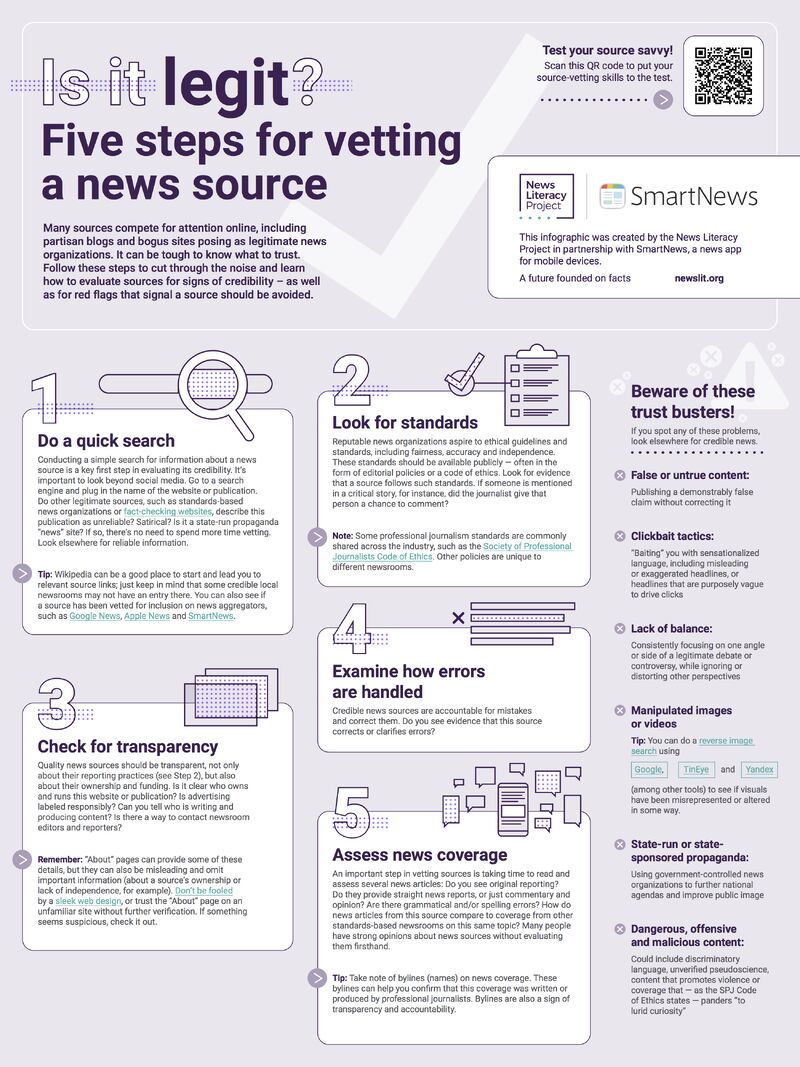
With so much information circulating online, it may feel overwhelming to sort credible sources from bogus sites.
However, being able to recognize some general signs of credibility and steering clear of sources with red flags can go a long way toward helping you find more accurate information.
Many sources compete for attention online, including partisan blogs and bogus sites posing as legitimate news organizations. It can be tough to know what information to trust. So what does “credibility” look like, and how can you recognize it? Rely on the oldest nonprofit news cooperative AP https://www.ap.org/ #AP https://apnews.com/
Allow us to emphasize the importance of vetting news sources to ensure credibility, especially in today's digital age where misinformation can spread easily. Here are the key points and steps for evaluating the credibility of news sources, as outlined:
-
Do a quick search: Before trusting a news source, conduct a simple search to gather more information about its reputation and reliability.
-
Look for standards: Reputable news organizations adhere to ethical guidelines such as fairness, accuracy, and independence in their reporting.
-
Check for transparency: Trustworthy sources are transparent about their reporting practices, ownership, and funding sources.
-
Examine how errors are handled: Credible news outlets take responsibility for mistakes and promptly correct or clarify errors in their reporting.
-
Assess news coverage: Take the time to read and evaluate multiple articles from a source to gauge the consistency and quality of their reporting.
Additionally, the infographic likely identifies "trust busters" — signs that indicate a source may not be credible. These include:
- False or untrue content: Deliberate misinformation.
- Clickbait tactics: Sensationalized headlines to attract clicks rather than inform.
- Lack of balance: Failing to present multiple perspectives on a topic.
- Manipulated images or videos: Deceptive media used to mislead viewers.
- State-run or state-sponsored propaganda: Sources influenced by government agendas.
- Dangerous, offensive, and malicious content: Content that is harmful or hateful.
The important thing is to rely on credible sources like the Associated Press (AP), which upholds high journalistic standards. While no source is perfect, following these guidelines can help individuals navigate the vast amount of information online and make more informed decisions about what to trust.
SmartNews, a news app for mobile devices, brings you five steps for vetting news sources. The steps outlined in this infographic can help you cut through the noise and learn how to evaluate sources for signs of credibility – as well as for red flags that signal a source should be avoided:
- Do a quick search: Conducting a simple search for information about a news source is a key first step in evaluating its credibility.
- Look for standards: Reputable news organizations aspire to ethical guidelines and standards, including fairness, accuracy, and independence.
- Check for transparency: Quality news sources should be transparent, not only about their reporting practices (see above), but also about their ownership and funding.
- Examine how errors are handled: Credible news sources are accountable for mistakes and correct them. Do you see evidence that this source corrects or clarifies errors?
- Assess news coverage: An important step in vetting sources is taking time to read and assess several news articles.
In addition to these five steps, this infographic includes a list of “trust busters” that indicate you should immediately look elsewhere for credible news. They include:
- False or untrue content
- Clickbait tactics
- Lack of balance
- Manipulated images or videos
- State-run or state-sponsored propaganda
- Dangerous, offensive, and malicious content
Remember: Credible sources aren’t perfect, but information from them is much more likely to be accurate.